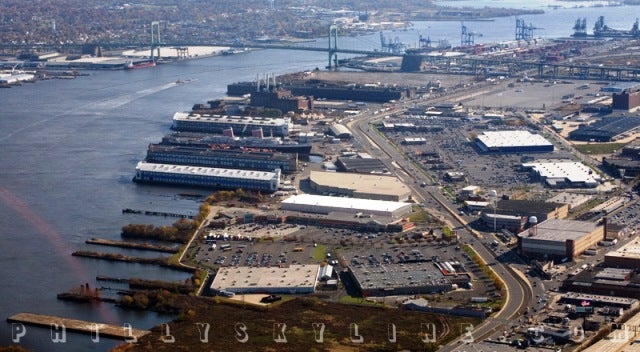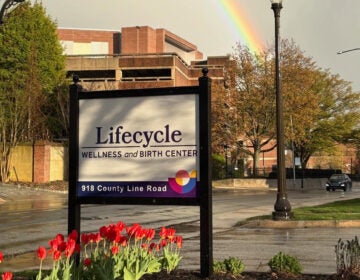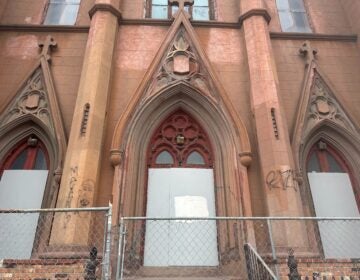Making Ridge Ave. more pedestrian-friendly
A bill limiting car use in parts of Roxborough has won a key victory in City Council.
Introduced by Councilman Curtis Jones Jr., the zoning bill seeks to revitalize Ridge Avenue between Hermitage St. and Monastery Ave., where Jones says developers have “[oriented] shopping centers towards the automobile rather than the pedestrian… [resulting] in irreparable damage.”
City Council reported the bill favorably out of the Rules Committee after its hearing, and placed it on the calendar for first reading.
To make the street more pedestrian-friendly, the bill prohibits several car-oriented businesses on Ridge Ave.: automobile repair shops, car washes, gas stations, car dealerships, car rental agencies and towing companies. It also places restrictions on parking lots, by disallowing vehicle access from Ridge Ave. and requiring that every lot with more than five parking spaces has landscaping.
The bill would make changes to Ridge Ave. unrelated to car use, as well. It would prohibit temporary employment agencies; and in order to provide an engaging experience for pedestrians on the street level, it would keep funeral parlors, labs, TV studios and business offices out of the first floor of buildings.
At Wednesday’s hearing, Jo Ann Desper, a board member of the Roxborough Development Corporation, testified in support of the bill. Her non-profit has created a master plan for the neighborhood that goes hand-in-hand with the restrictions imposed by Jones’ bill. The plan identified Ridge Avenue as the neighborhood’s downtown business district.
“A lot of people like myself are trying hard to brand Roxborough as fun for family, shopping and dining,” said Desper, adding that the bill would help create “a pleasant experience and walk along the Ridge.”
Though Council will almost certainly pass the bill, there’s no telling how long it will stay on the books. The Zoning Code Commission is currently rewriting the city’s zoning code, which it will send to Council for approval next year. So far, it’s taken out huge swaths of neighborhood “overlays” — aka restrictions on what businesses can operate in an area, how tall buildings are and what signs look like, among other things.
Since Jones’ bill creates such an overlay, it could vastly change once the Commission gets its hands on it.
WHYY is your source for fact-based, in-depth journalism and information. As a nonprofit organization, we rely on financial support from readers like you. Please give today.
Waterfront overlay gains traction

Full Council will vote today on bill that calls for a conditional 100-foot setback and public access. A parcel north of the Delaware Power Station and south of the Conrail Lands was rezoned from Industrial to C-3.
Photo courtesy of Brad Maule, check out his complete portfolio at www.phillyskyline.com/lovecopter
June 4, 2009
By Kellie Patrick Gates
For PlanPhilly
Legislation aimed at creating a multi-use riverfront trail, a dense retail/commercial corridor, and connections between neighborhoods and the Delaware River via a zoning overlay that would stretch between Oregon and Allegheny Avenues was introduced to City Council Thursday morning.
Wednesday afternoon, Council’s Rules Committee unanimously passed two bills, which would create the Central Delaware Riverfront Overlay District, after listening to passionate testimony, both pro and con. Full Council is set to vote on passing the legislation at Thursday’s meeting.
The Civic Vision was created by PennPraxis at the request of former mayor John Street and is based on more than a year of community input. The Vision has been endorsed by Mayor Michael Nutter and Planning Commission Executive Director Alan Greenberger. And the Planning Commission has agreed to use its principles as a guide in crafting the Master Plan for the Central Delaware, which is expected to be completed in 12 to 18 months.
The Master Plan and affiliated zoning would replace the overlay. First District Councilman Frank DiCicco introduced the overlay legislation in March, describing it as a stop-gap measure. A link to the ordinance describing the overlay follows this article.
The majority of individuals who testified Wednesday spoke in favor of the legislation, agreeing with DiCicco that it is a necessary step to protect the 7-mile stretch from any projects that would preclude developing the waterfront in accordance with the Civic Vision for the Central Delaware.
Steven Weixler, chairman of the Central Delaware Advocacy Group – an organization of riverfront neighborhood representatives created to advocate for the Civic Vision – said the overlay legislation isn’t perfect, but it goes a long way toward establishing waterfront access and providing development guidelines that would protect the waterfront until a new master plan and zoning is in place. He said both the green space it sets aside and the type of development it encourages would bring businesses and home owners to the area.
“Council has the chance to enact an interim ordinance which would not bring development in the area to a dead stop, but would allow a progressive administration to thoughtfully consider the future of a great asset to Philadelphia,” Weixler said. Read his full testimony below. Several others individuals who testified in favor of the bill are also CDAG members, but said they were testifying on behalf of their community groups or organizations.
Pete Hoskins, president of the Philadelphia Parks Alliance, said that parks and green space have strong economic benefits for neighborhoods. Maya Van Rossum, the Delaware Riverkeeper, said that on her monitoring tours she sees people who have climbed over all manner of impediments to get the few natural spaces along the water, and that the 100-foot buffer could not only create a natural area with easy access, but prevent development where it is most susceptible to flooding.
But three representatives of a pro-development non-profit called the Development Workshop urged the committee to table the legislation, saying that the setbck would amount to a taking of private land with no compensation to the landowners, and that the trail should be plotted and costed out before legislation to create it is enacted. They also said that the bills give too much power to the Planning Commission, because once the Commission crafts a set of specific development guidelines, the Commission would have the final say on project approval – Council would not vote. And they were concerned that the 180-day window, which is the time the Commission has to draft the guidelines, would essentially be a moratorium on building, because no developer could propose a project without knowing exactly what he or she can do with their property.
“This creates an entire zone where it will not be this Council, but it will be the Planning Commisison that makes a stop or go decision,” said Michael Sklaroff, Development Workshop chairman.
Sklaroff said that not only is it a bad idea to give the Planning Commission this power, but it violates the City Charter. On behalf of his organization, Sklaroff sent a letter to the City Law Department outlining the ways in which he thinks the overlay proposals violate the charter.
DiCicco said it seemed Sklaroff, a partner with the law firm of Ballard Spahr Andrews & Ingersoll and chair of the real estate department, was gearing up for a lawsuit. That would really delay development, he said.
Sklaroff said the Development Workshop had simply asked the city’s legal department to look at the issues raised in the letter. “We’re not gearing up for anything,” he said.
DiCicco said there has been a review. “The law department disagrees (with the Development Workshop objections). They think it’s legal. We’ve talked to them,” he said. After the meeting, DiCicco’s chief of policy, Brian Abernathy, said the councilman has asked the city’s legal department to produce a written report on their findings, but that it was not ready.
When asked after the hearing if a lawsuit was a possibility if City Council passes the overlay legislation, Sklaroff had no comment.
Councilman James Kenney also spoke to Sklaroff about the development delays he said the legislation would cause. Kenney asked Sklaroff for the average length of time the waterfront landowners, who are part of the Development Workshop, have owned their properties. Sklaroff said about 12 years. Kenney asked why more of them haven’t developed before now, particularly if they need to develop their properties quickly.
Were they buying land to speculate on casino gambling Kenney wanted to know? DiCicco grinned. Sklaroff said the purchases were absolutely not about gambling, but related to the demand for residential housing that was just starting to grow, but now has plummeted. He also said more development would occur if Philadelphia had clearer development guidelines and a more transparent process. DiCicco chimed in that having a vision for the waterfront would give developers a clear understanding of what the city wants, and would make things more clear. He also said that some city developers had looked at the legislation “within the last 24 hours” and were just fine with it.
While parties on both sides of the issue seemed to agree that precise guidelines would foster more and better development, proponents said the overlay would make things clearer, while opponents maintained it leaves too much unanswered, and would muddy the waters.
It’s not just Development Workshop members who think the legislation, as written, could land the city in court.
Larry Silver, an environmental, zoning and land use attorney with Langsam Stevens & Silver told the committee he reviewed the overlay legislation at the request of the Pennsylvania Environmental Council, and he also read Sklaroff’s letter. (PEC vice president Patrick Starr also testified in favor of the legislation)
“I wholeheartedly support this bill and am confident that it will improve the character, image, functionality and beauty of the city,” Silver said. “It seems apparent that the bill may be challenged in court following passage.” Like Sklaroff, much of what Silver sees as problematic is the amount of power given to the Planning Commission. A link to the full text of Silver’s testimony follows this article.
The language in the bill that describes the overlay rules says that the Planning Commission determines whether the setback requirement is not feasible for a particular property, based on the standards for the overlay that the Planning Commission will create.
“The contemplated ‘exception’ to the Waterfront Setback is a zoning variance, nothing more, nothing less,” Silver said. And it’s the Zoning Board of Adjustment that is empowered by the Home Rule Charter to consider variations.
As the proposed legislation now stands, after the Planning Commission has finished creating the overlay rules, a developer would have to present a plan of development to the Commission for approval. And it is the Commission that would then either approve or vote against the plan. City Council would not consider it. Silver said there’s a legal question whether the city’s charter allows this, but also an easy fix: The Planning Commission would consider and hold hearings on the development plans, but then make a recommendation to Council, which would have the final say.
Before Wednesday’s meeting, the zoning overlay proposal required developers to start submitting plans of development immediately after passage, before the Planning Commission created the set of guidelines. This is one of the reasons the Development Workshop felt the proposal contained a development moratorium. Abernathy said that under the revised version, all other provisions go into effect immediately – a setback and trail would still be required, for example. Sklaroff and Development Workshop Executive Director Craig Schelter said after the vote that they needed time to analyze the new version before they could comment on the change.
When the hearing began, the important part of another controversial section of the bill – the size of the setback – was blank. Earlier versions had it as at least 50, but not greater than 100 feet. Schelter said that even the lower end was far too much land on some properties, especially if there was no compensation for landowners. But others said there would be a way for exemptions in those cases.
Penn Praxis’ Executive Director Harris Steinberg was among those asking for the 100-foot minimum setback. In some areas of the Central Delaware, that’s already impossible, he said. “This legislation is our opportunity to set a high bar for future development, so that we may enjoy all of the economic, environmental and health benefits that generous access to the river will yield,” he said.
Later in the meeting, DiCicco submitted an amendment that filled in the setback size numbers: 100 feet or 10 percent of the property, whichever was less. Some advocates cheered when the 100 foot part was read. But CDAG had been hoping for a minimum of 20 percent.
“It would be a huge mistake for us not to take a moment and marvel at what an impressive acomplishment this overlay is. No one could have even imagined it four years ago,” said CDAG member Matt Ruben on Thursday afternoon. Ruben said he would like to see the largest waterfront setbacks possible, “But whether it’s 10 percent or 20 percent, it’s a quantum leap from what we have now. And whatever the number is, the setback will become more precise and better defined in the eventual Master Plan.”
Ruben testified Wednesday on behalf of the Norther Liberties Neighbors Association. The text follows this article.
The positions of CDAG and the Development Workshop were no surprise to DiCicco – or to the members of the organizations. Representatives from both groups met with DiCicco and Abernathy to talk about their differences as the legislation moved through its various drafts.
Another issue irksome to both sides for different reasons: Waterfront access. The Development Workshop says access through certain properties – heavily industrial ones, for example – is just not a good idea, for safety and liability reasons. CDAG, on the other hand, has been worried that there would not be enough access.
The legislation states that “two or more adjacent property owners may share access via an easement agreement between the parties.” Silver suggested that this language is too open ended. “It is possible, as this is worded, for example, for ten adjacent property owners to agree that one access route on one of the properties will be provided to satisfy the agreement,” he said. He suggested a change requiring the easement to be “along the boundary lines between their adjacent properties.”
In other action: The Rules Committee unanimously approved a bill that creates a setback and trail along the northern stretch of the Delaware River, called the Delaware River Conservation District. The setback is 50 feet, participation is voluntary, and a large amount of grant money will fund the work. Critics of the overlay like this approach much better.
The Committee also unanimously passed out of committee an ordinance to change the zoning designation of land that was once a potential casino location from industrial to mixed use development. The land is owned by James Anderson and was the proposed site of the Pinnacle Casino, which was not selected by the Pennsylvania Gaming Control Board as one of the two Philadelphia casino projects. “Mr. Anderson would like to be in a better position to market his property,” said the attorney representing him, Tom Chapman, and the change would help him do that. The land is bounded by a line located approximately 220 feet north of Cumberland Street, the Delaware River, a line located approximately 328 feet south of Berks Street, Beach Street, Richmond Street, Schirra Drive, Beach Street and Cumberland Street.
Contact the reporter at kelliespatrick@gmail.com
WHYY is your source for fact-based, in-depth journalism and information. As a nonprofit organization, we rely on financial support from readers like you. Please give today.








